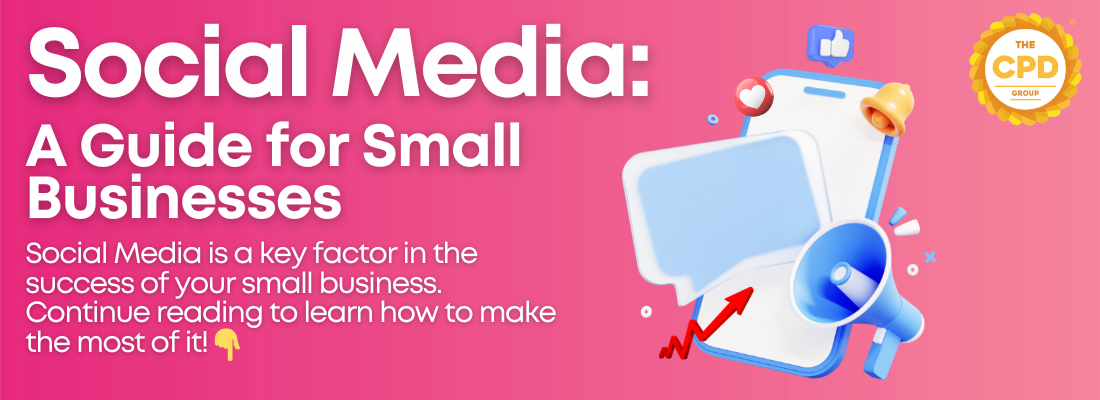Social Media: A Guide for Small Businesses
Social media is an effective tool for small businesses that can be used to connect with your target audience and attract new clients. According to recent statistics, individuals will spend 3.4 million minutes, or 6 years and 8 months, on social media over their lifetime. Crazy, right?! With social media being more widely used than ever, it’s a key factor in the growth of your small business and can help you achieve your business goals! 🙌
But how can your small business use social media to accomplish your goals? Continue reading to find out!
1) Set your goals
It's a bit of a no-brainer, but in order to reach your goals, you first have to set them! Ask yourself what you want to get out of social media. Do you want to increase your brand awareness? Boost your customer engagement? Drive more people to your website? Once you have your objectives in place, you can work to begin achieving them.

2) Determine your audience
The next thing to do is to determine who you’re targeting. It’s no good creating posts that don’t resonate with the people you’re selling to. You may have different target audiences for different services and products you offer, so it’s key to assess your business from all angles. In order to determine your audience, you may do the following:
-Analyse your current customers
-Carry out market research
-Study your competitors
-Create personas
3) Choose your platforms
Your target audience will play a significant role in determining which social media platforms you want to concentrate on. Businesses that engage in B2B (Business to Business) interactions may find more value in professional social networking platforms like LinkedIn. If your audience is a younger demographic, platforms like TikTok and Instagram may be a better fit for you.
4) Creating content
Once you’ve set your goals, determined you audience and chosen your platforms, it’s time to start creating content to get out to your audience! It’s important to create content that is engaging and holds your customers attention, but also adds value to your brand. Video-based posts are proven to generate the most engagement – so it’s a good idea to schedule a few video based posts each week. This could be a product demonstration, jumping on a TikTok trend or a customer testimonial. There are some great tips for creating video-based content here!
There are some excellent free and low-cost content creation platforms out there. For example, Canva has loads of free assets and templates to help spruce of your social posts. It’s also important to include a call to action in every post you make, that directs your customers to your website or encourages them to get in touch.

5) Scheduling content
Running a small business can get super busy, so it’s important to stay ahead of things, including your social posts. Scheduling your social posts ahead of time is a great way to ensure consistency across your social accounts and save time for other important tasks. There are plenty of affordable tools for scheduling posts, such as Hootsuite, Sendible, Sprout Social, SocialPilot and more!
6)Don’t just sell, sell, sell!
Even though your end goal may be increasing your sales, steer away from bombarding your audience with sales talk. This is a sure-fire way to turn off your customers and lead them to hit that dreaded unfollow button. Social media is all about creating rapport with your audience and building a great reputation for your brand. Break up the more sales focused posts with posts that add more value to your audience and humanise your business. This could be posts that offer useful tips to your audience, updates on the latest news from your industry or creating more engagement by asking your audience questions.
7) Interact with your audience
One of the best ways to keep your audience engaged with your brand is to interact with them! If you receive comments, be sure to stay on top of responding to them. If your customers share posts about your product, be sure to repost these to your page. Encourage your customers to share their experiences with your product or services by using a dedicated hashtag. Create a dedicated Facebook group for your customers and keep them in the loop about your latest updates. Keep the conversation flowing and show your customers that you’re there for them!

8) Paid promotions
If you're just starting out and want your content to reach a larger audience, consider using the paid promotion features of social media sites like Facebook, Instagram, and Twitter. Paid promotions are a fantastic way to take your social media to the next level and boost your following and reach more people from your target demographic!
9) Be consistent!
In order to effectively establish your social media presence, consistency is essential. For instance, it's crucial to maintain consistency in your posting. This may be helped by planning your publishing schedule and scheduling posts in advance. Additionally, it's critical to maintain brand coherence throughout all of your websites, social media accounts, physical locations, and other promotional materials you may have. This makes it simpler for customers to recognise and discover you on social media and contributes to the development of a consistent brand image.
If you’re CPD Accredited Provider, Trainer, or have Activities accredited with us, don’t forget to share your certificates and logos on social media to demonstrate your credibility to your customers! (and don’t forget to tag us and use the hashtag #TheCPDGroup 😉)


Discussion (0)
Join the conversation and share your insights with our community
Join Our Community
Share your expertise, ask questions, and engage with fellow CPD professionals
Start the Conversation
Be the first to share your thoughts on this article. Your insights could help other professionals in their CPD journey.